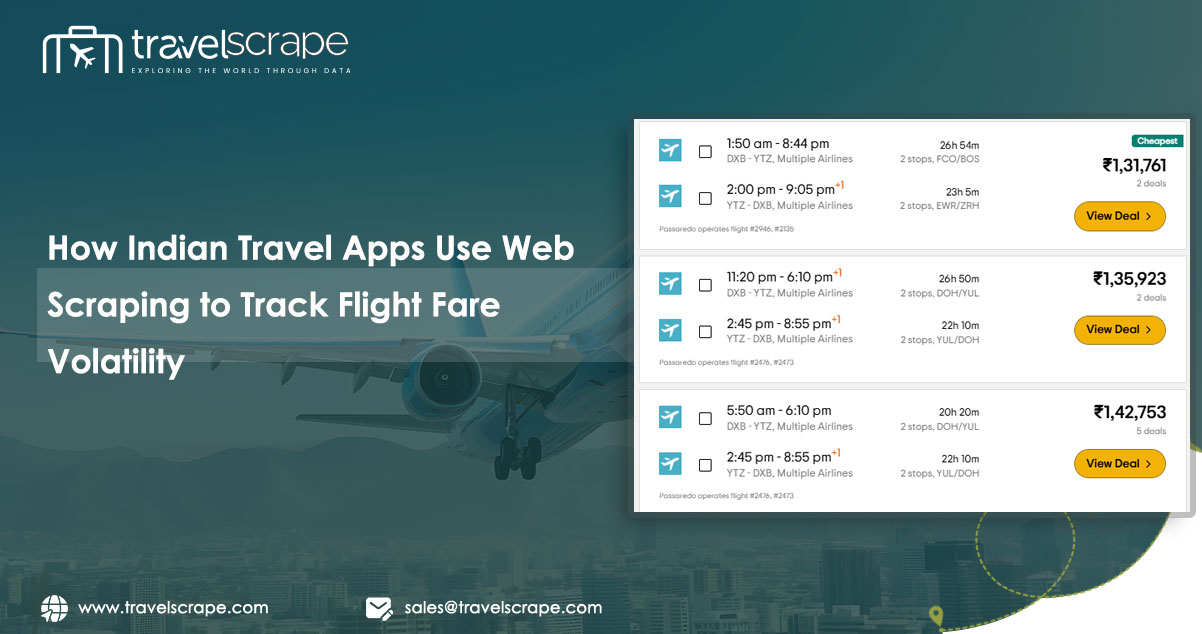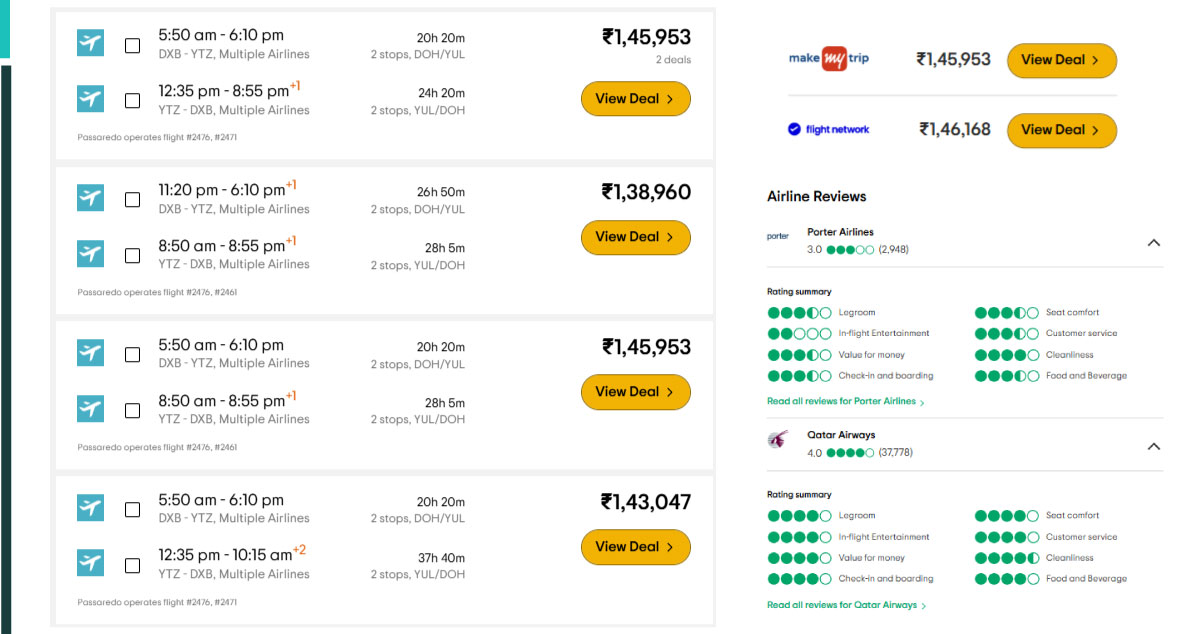How Indian Travel Apps Use Web Scraping to Track Flight Fare Volatility

In a price-sensitive market like India, where budget-conscious travelers compare across platforms before hitting "Book Now," real-time fare insights are crucial. Flight prices can change dozens of times a day, and Indian travel apps are now using web scraping to track these fluctuations and deliver smarter experiences.
This blog explores how Indian travel platforms like Ixigo, Cleartrip, Goibibo, and MakeMyTrip are leveraging web scraping for flight fare volatility tracking and how Travel Scrape is enabling startups and OTAs to do the same.
Why Flight Fare Volatility Matters in India

Flight ticket pricing is dynamic and unpredictable. Prices are influenced by:
- Booking window (e.g., 15 days vs. same day)
- Seat inventory
- Competitor pricing
- Fuel costs
- Route popularity (e.g., Delhi → Mumbai vs. Patna → Ranchi)
- Festivals, holidays, and political events
A one-way Delhi to Bengaluru ticket can range from ₹3,000 to ₹8,000+ within a week depending on the timing. This volatility makes it essential for apps to offer real-time, comparative fare data to win over users.
What is Web Scraping in Travel?
Web scraping is the automated collection of publicly available data from websites. For travel apps, this includes:
- Live flight prices from airline sites (IndiGo, Air India, Vistara, SpiceJet)
- Aggregated pricing from OTAs (Skyscanner, Google Flights, MakeMyTrip)
- Availability and seat class data
- Fare breakdowns (base fare + taxes + convenience fee)
- Dynamic promos and coupon codes
Travel Scrape’s Web Scraping Model for Indian Flight Fares
Travel Scrape offers tailored scraping infrastructure for Indian travel players to monitor flight fares across cities and timelines. Here's how:
1. Route-Based Scraping
Our engine targets popular domestic and international Indian routes:
- Delhi → Mumbai
- Bengaluru → Goa
- Hyderabad → Kochi
- Chennai → Dubai
- Mumbai → Singapore
2. Date-Wise Monitoring
- 30-day price calendars scraped daily
- Last-minute fare fluctuations
- Price changes based on time-of-day (morning vs. red-eye)
3. Airline & OTA Tracking
Scrapes fares directly from:
- Airline websites: IndiGo, Vistara, AirAsia India, Akasa
- Aggregators: Yatra, Cleartrip, EaseMyTrip
4. Mobile & Web Versions
Scraping both mobile-optimized flight rates and desktop listings to detect promo discrepancies
5. Alerts & API Delivery
- JSON APIs for fare volatility feeds
- Alerts when price drops 10%+ on tracked routes
- Comparative snapshots for marketing campaigns
| Date | Airline | Fare (₹) | Class | Booking Site | Change (%) |
|---|---|---|---|---|---|
| May 14 | Indigo | ₹4,250 | Economy | Goibibo | +5% |
| May 15 | Air India | ₹3,980 | Economy | MakeMyTrip | -7% |
| May 16 | Vistara | ₹4,600 | Premium | Airline Site | +2% |
| May 17 | Akasa Air | ₹3,760 | Economy | Ixigo | -3% |
| May 18 | SpiceJet | ₹4,020 | Economy | Yatra | -1% |
Benefits for Indian Travel Apps

Smarter Fare Comparisons
Apps can display real-time fare volatility to users, helping them decide the best booking time.
Price Drop Alerts
Scraping enables instant detection of sudden fare drops, triggering alerts that boost conversion.
Predictive Pricing Engines
Historical scraped fare trends help apps predict future pricing, ideal for features like “wait or book now” insights.
Enhanced Marketing Campaigns
Scraped fare data powers city-based promo campaigns like: "Lowest Bengaluru Flights This Weekend – Book Before 10 PM"
Festival-Based Fare Tracking
Apps can pre-plan Diwali, Holi, and summer vacation campaigns using scraped trend data.
Legal Considerations
While scraping public data is generally legal in India if done ethically, Travel Scrape ensures:
- Respect for robots.txt files
- Avoidance of login-restricted data
- Use of rotating proxies and throttling to prevent load on airline/OTA systems
- Compliance with platform terms where required
Integration with Indian Travel Ecosystems
1. Fare Prediction Modules
Travel Scrape’s volatility datasets feed into machine learning models for apps to predict the right time to book.
2. SEO Boost via Landing Pages
Websites build SEO pages like “Cheap Flights from Delhi to Goa under ₹4000” with daily refreshed scraped prices.
3. Ad Campaign Optimization
Flight price trends inform Google Ads copy like: “Delhi to Mumbai Flights from ₹3,900 | Book Today | 20% Off”
Regional and International Use Cases
Domestic Travel
- Tracking price volatility across Tier-2 cities like Lucknow, Nagpur, Bhubaneswar
- Helping budget carriers optimize load factors
International Corridors
- India → UAE (Dubai, Abu Dhabi)
- India → UK (London, Manchester)
- India → Southeast Asia (Bangkok, Kuala Lumpur)
Apps use scraped data to:
- Compare airline vs. OTA pricing
- Detect airline-offer cycles
- Power visa+flight package bundles
Future of Fare Scraping in Indian Travel

As AI and personalization grow, scraped fare data will power:
- Personalized booking timelines (“You usually book 15 days before, this is your best fare now.”)
- Voice search integration (Alexa: “Find me cheapest Mumbai to Jaipur flight next week”)
- Hyperlocal airport insights (fare trends from Pune vs. Mumbai)
Why Travel Scrape?
- Deep Coverage of Indian Domestic Routes
- Real-Time, Hourly Scraping Available
- Historical Fare Trend Dashboards
- Seamless API for App Integration
- Legal-Compliant and Scalable
Final Thoughts
Indian travelers demand agility, accuracy, and affordability. Travel apps that leverage real-time web scraping of flight fare volatility are positioned to win trust, conversions, and market share.
Travel Scrape empowers OTAs, travel startups, and meta-search engines to harness this volatility into actionable pricing intelligence.
Let your users fly smarter.
Let your platform scrape sharper.

